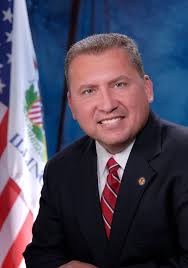 This month DonorDreams is hosting the nationally acclaimed Nonprofit Blog Carnival, and this month’s theme is: “If you could go back in time and give your younger-fundraising-self one piece of advice, what would it be?” As I’ve done each of the last three year’s when I’ve hosted the carnival, I plan on focusing this month’s DonorDreams blog posts on the topic as a way to help inspire other non-profit bloggers to submit posts for consideration. The April 2016 Nonprofit Blog Carnival is scheduled to go live on Thursday, April 28, 2016. So, mark your calendars because you won’t want to miss what other non-profit bloggers have to say on this topic.
This month DonorDreams is hosting the nationally acclaimed Nonprofit Blog Carnival, and this month’s theme is: “If you could go back in time and give your younger-fundraising-self one piece of advice, what would it be?” As I’ve done each of the last three year’s when I’ve hosted the carnival, I plan on focusing this month’s DonorDreams blog posts on the topic as a way to help inspire other non-profit bloggers to submit posts for consideration. The April 2016 Nonprofit Blog Carnival is scheduled to go live on Thursday, April 28, 2016. So, mark your calendars because you won’t want to miss what other non-profit bloggers have to say on this topic.
Today’s time machine post involves a younger me who learned valuable lessons about direct mail after a fateful experience with one of my first year-end holiday appeals. Enjoy!
 As a teenager, I was a Rocky Horror Picture Show groupie, which I bet you couldn’t have guessed, especially now that I routinely wear a tie and constantly talk about non-profit, fundraising and organizational development stuff. I’ve seen this cult movie more than 50 times in my life,
As a teenager, I was a Rocky Horror Picture Show groupie, which I bet you couldn’t have guessed, especially now that I routinely wear a tie and constantly talk about non-profit, fundraising and organizational development stuff. I’ve seen this cult movie more than 50 times in my life,
So, there you have it. LOL
I only mention this weird little personal fact about me because today is Tim Curry’s 70th birthday. For those who have experienced this movie, you understand that Curry’s Rocky Horror character, Dr. Frank-N-Furter, is a time traveling transvestite from outer space. Of course, I only mention all of this because this month’s Nonprofit Blog Carnival is time travel related.
Speaking of going back in time, if I had the opportunity to do so, one place I might stop top give my younger-fundraising-self a little advice would be November 2001. I was a relatively new executive director, and I was grappling with how to bring the cost of my year-end holiday mail appeal down.
 Instead of picking up the phone and talking to mail professionals, that 31-year-old executive director decided to engage a few friends and do a 12,000 piece mailer by himself. Uh-huh. I thought it would be easy to:
Instead of picking up the phone and talking to mail professionals, that 31-year-old executive director decided to engage a few friends and do a 12,000 piece mailer by himself. Uh-huh. I thought it would be easy to:
- Print everything in-house
- Fold
- Stuff
- Stamp (pre-paid nonprofit stamps)
- Lick
- Sort
- Box
- Deliver to the post office
I’m sure you have already guessed that my friends quickly abandon ship after the first few hours and figuring out the insanity of what I was asking.
But did you skip over the bullet point labeled “LICK“.
Ugh!
Somewhere after the first few hundred letters, I made the decision that the wet sponge was just too sloppy. So, instead of using less water, I made the horrible decision to lick every stamp and every envelope.
When I think back to that moment in time, I still get that HORRIBLE taste in my mouth I experienced at the end of that long weekend. <ick>
If time travel was possible, I would go back and provide the following advice to my younger-fundraising-self:
- Don’t quickly dismiss the idea of calling a mail house because they might have been able to save you money with CASS certification and bar code automation (e.g. you never know unless you ask . . . work smart)
- Don’t lick those stamps and envelopes (it won’t save you any more money . . . it won’t raise you more money . . . it might even make you sick)
If you are a non-profit blogger who wants to participate in this month’s Nonprofit Blog Carnival and submit a post for consideration on this month’s carnival theme, click here to read the “call for submissions” post I published last week. It should answer all of your questions and clearly explain how to submit your entry. If not, then simply email me and I’ll be happy to help.
Here’s to your health! (And Happy Birthday, Tim!)
Erik Anderson
Founder & President, The Healthy Non-Profit LLC
www.thehealthynonprofit.com
erik@thehealthynonprofit.com
http://twitter.com/#!/eanderson847
http://www.facebook.com/eanderson847
http://www.linkedin.com/in/erikanderson847

 As a young Boy Scout professional in the 1990s, I was just starting to learn may way around fundraising principles and best practices. While I previously had helped out with a few special events and written a grant proposal for another organization, I never helped plan-organize-implement an annual campaign pledge drive, which is what I was being asked to do with a group of Friends of Scouting (FOS) volunteer within my district.
As a young Boy Scout professional in the 1990s, I was just starting to learn may way around fundraising principles and best practices. While I previously had helped out with a few special events and written a grant proposal for another organization, I never helped plan-organize-implement an annual campaign pledge drive, which is what I was being asked to do with a group of Friends of Scouting (FOS) volunteer within my district. Fast forward a number of years into the future when I was a first-time executive director for a Boys & Girls Club.
Fast forward a number of years into the future when I was a first-time executive director for a Boys & Girls Club. Sometimes when I daydream, I see myself standing outside my house in the street with Dr. Emmitt Brown (aka Christopher Lloyd’s character in Back to the Future), waiting for the lighting storm so I can jump into that
Sometimes when I daydream, I see myself standing outside my house in the street with Dr. Emmitt Brown (aka Christopher Lloyd’s character in Back to the Future), waiting for the lighting storm so I can jump into that  Ahhhh, yes. I remember this embarrassing lesson very well. It occurred in the late 1990s when I was a young Boy Scout professional who was responsible for membership management, district-wide programming, local unit support and fundraising for a small suburban district in the Northwest Chicago suburbs. It was the 20th Century and the idea of email was new and evolving as a way to communicate with non-profit volunteers.
Ahhhh, yes. I remember this embarrassing lesson very well. It occurred in the late 1990s when I was a young Boy Scout professional who was responsible for membership management, district-wide programming, local unit support and fundraising for a small suburban district in the Northwest Chicago suburbs. It was the 20th Century and the idea of email was new and evolving as a way to communicate with non-profit volunteers. To better understand what I just said, I will use a simple analogy . . .
To better understand what I just said, I will use a simple analogy . . . Sometimes, when I’m daydreaming, I imagine myself in a time machine going back to 1999 to have a serious conversation about email usage with my younger-fundraising-self. I also sometimes wonder if it would be helpful to take a page out of the Arnold Shwarzenegger Terminator movies by traveling back in time to sabotage the work of the person who created email. 😉
Sometimes, when I’m daydreaming, I imagine myself in a time machine going back to 1999 to have a serious conversation about email usage with my younger-fundraising-self. I also sometimes wonder if it would be helpful to take a page out of the Arnold Shwarzenegger Terminator movies by traveling back in time to sabotage the work of the person who created email. 😉 Is your nonprofit organization trying to break into the millennial space in order acquire and retain more millennial donors?
Is your nonprofit organization trying to break into the millennial space in order acquire and retain more millennial donors? Zach Hagopian is the co-founder and COO of
Zach Hagopian is the co-founder and COO of  A few months ago I was onsite with a client and found myself working with a young fundraising professional. They hadn’t been on the job for long. In fact, their background wasn’t even in resource development. If my memory serves me well, then I think they had a college degree and an internship’s worth of experience in marketing or public relations.
A few months ago I was onsite with a client and found myself working with a young fundraising professional. They hadn’t been on the job for long. In fact, their background wasn’t even in resource development. If my memory serves me well, then I think they had a college degree and an internship’s worth of experience in marketing or public relations. Later that evening, I was working from the hotel room with the television chirping away in the background. One of the “Back to the Future” movies was the evening feature. Ignoring Michael J. Fox and focusing instead on my work from earlier in the day, I started thinking about all of the fundraising mistakes I had made (and hopefully learned from) when I was younger.
Later that evening, I was working from the hotel room with the television chirping away in the background. One of the “Back to the Future” movies was the evening feature. Ignoring Michael J. Fox and focusing instead on my work from earlier in the day, I started thinking about all of the fundraising mistakes I had made (and hopefully learned from) when I was younger. Let’s have a little fun with this topic. It lends itself nicely to it. Right? 😉
Let’s have a little fun with this topic. It lends itself nicely to it. Right? 😉 You are welcome to write your blog post anytime during the month of May (or even submit a post you may have previously published); however, I must receive your submission by the end of the day on Monday, April 25, 2016:
You are welcome to write your blog post anytime during the month of May (or even submit a post you may have previously published); however, I must receive your submission by the end of the day on Monday, April 25, 2016:
 Earlier this week and last week, I started writing about the State of Illinois’ budget crisis and how it is impacting non-profit organizations. In
Earlier this week and last week, I started writing about the State of Illinois’ budget crisis and how it is impacting non-profit organizations. In  Don’t want to take my word for it because you might have heard it from your grandfather or another beloved family member. No problem … I completely understand. Let me provide you with scientific proof. Simply
Don’t want to take my word for it because you might have heard it from your grandfather or another beloved family member. No problem … I completely understand. Let me provide you with scientific proof. Simply  Your board is likely made up of smart people. If they aren’t being used (at a minimum) as a “sounding board” on the issue of government funding and what to do about it, then my suggestions are:
Your board is likely made up of smart people. If they aren’t being used (at a minimum) as a “sounding board” on the issue of government funding and what to do about it, then my suggestions are: Of course, the more difficult question for most non-profit organizations is “What to do about it?”
Of course, the more difficult question for most non-profit organizations is “What to do about it?”
 Here is what I didn’t expect to hear:
Here is what I didn’t expect to hear: Believe it or not, this phenomenon has a name. It is called the
Believe it or not, this phenomenon has a name. It is called the  One of my favorite movie scenes is at the
One of my favorite movie scenes is at the  You have lots of short-term options that will help bridge your organization through a cash flow crisis. The following is a short list of some of those options:
You have lots of short-term options that will help bridge your organization through a cash flow crisis. The following is a short list of some of those options: If I’ve seen it once, I’ve seen it a number of times . . . board volunteers want to hold someone accountable after the crisis passes. In my opinion, the best way to survive this dynamic is to be able to point to:
If I’ve seen it once, I’ve seen it a number of times . . . board volunteers want to hold someone accountable after the crisis passes. In my opinion, the best way to survive this dynamic is to be able to point to: Now that you’ve made it through the crisis and have a firm understanding of what caused it, it is important have a new long-term plan that keeps you from ending up back from where you just came.
Now that you’ve made it through the crisis and have a firm understanding of what caused it, it is important have a new long-term plan that keeps you from ending up back from where you just came.